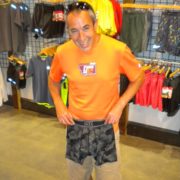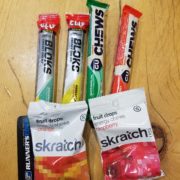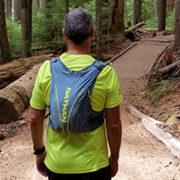Jesse Carnes is a RErun Ambassador for 2017/2018. He is a prolific racer and recently finished up a season that saw him complete the Butte 100 Mountain Bike Race, pace the Missoula Marathon, finish the Portland Marathon, and finish all three days of racing at the Rut Mountain Runs among a slew of other races. Jesse has been in the endurance world for years and continues to run outside no matter the weather. Here is one of Jesse’s tricks for battling the darkness. You can read more about Jesse’s adventures here.
So there we all were, enjoying a nice fall. The leaves were making their lazy journey from their high perches down to the ground below, where we would put off raking them until the very last minute, under the guise of there being fewer left to fall after said raking was done, but really just because we are lazy and like to procrastinate. there was a nice coat of larch needles on all the trails around town, still just enough light in the mornings and evenings I didn’t yet have to ride my bike in the dark, at least not every day. A nice coat of snow covered everything just in time for the Elk Ramble 15k, and we all got to trudge around in the snowiest race of the year. We all thought it was winter then, but fall came back.
As November wore on, though, it wasn’t the cold or the snow that drove home the point that winter is quickly on its way. No, the real, consistent proof of that fact, the part that never changes from year to year depending on the current season’s weather patterns, is the darkness. Soon, it will just barely be light when I leave for work in the morning, and it has already been dark for a solid hour when I go home in the evening.
All this is to say, if I want to keep running through the winter, and I do, a good bit of it will be happening in the dark. And that brings me to my main point: lights!
I have always been a headlamp kind of guy in the past. They have the advantage of increasing the visibility of the runner while also allowing you to see that rock or curb quickly approaching. As a side note, they by no means guarantee that you won’t trip over that curb. It’s possible that a certain unnamed individual did a faceplant after tripping over a snow-covered curb doing intervals in the dark in Greenough Park last winter. It’s also possible that individual was me. Not saying one way or the other for sure.
Headlamps have their downfalls, though. The most obvious: vehicle drivers can’t see them from behind. Also, many people find them uncomfortable. This necessitates a search for other lighting options. The most recent one I tried out and am reviewing today is an arm band. Specifically, the Nathan Lightbender RX.
I had never used an arm band before, and my first thought was that I would prefer something that wrapped around the arm more snugly. The Lightbender essentially forms kind of a D-shaped loop, and, at least if you have little chicken arms like me, it fits fairly loosely, even when tightened down all the way. While I was worried this would bounce around an be obnoxious, it turned out to not be that big of a deal. It did work its way down to my elbow as I ran instead of staying up higher, but it was still comfortable and didn’t feel like it was flopping around all over the place.
The unique (and fun) feature of the Lightbender RX is that you can change the color of the light. There are three options (red, green, blue), so you can pick whichever one suits your mood that day, or you can really geek out and try to research which color is the most visible to passing motorists. The internet has less to say about this than I thought it might, but the overall consensus seems to be somewhere between green and yellow. Since yellow isn’t one of the choices, one might choose green. Then again, green means go, so perhaps red would instill more caution in drivers. Or, maybe you don’t want to blend with a sea of traffic lights, so you choose blue to stand out a bit more. As you may have gathered, there is no right or wrong choice, and that’s why there are three of them.
The method of changing the light color was not immediately intuitive for me, and the instructions didn’t help. They said to turn on the light, then double tap the power button, but what they really meant was, turn on the light and then hit the button again right after the light turns on. Maybe I’m crazy, but to me that means two different things. Anyway, I eventually figured it out and happily flipped my way through the color options.
One last factor with any kind of light that is worth paying attention to is battery life. Nathan advertised the battery life as 8 hours on steady mode or 16 hours flashing. I would definitely encourage any user to pay attention to how long it’s been since the light was last charged, because like fall turning to winter, waning battery power is a gradual process. If you’re not careful, before you know it, you’ll be in the dark.
-Jesse













